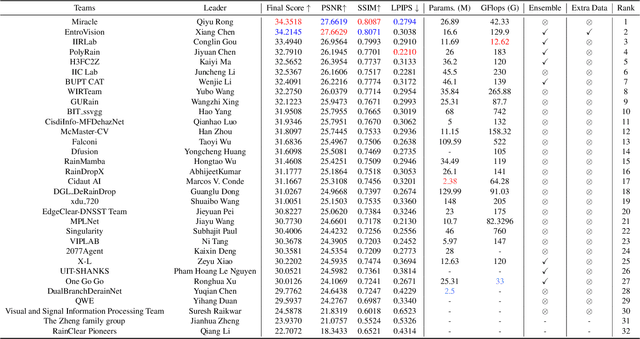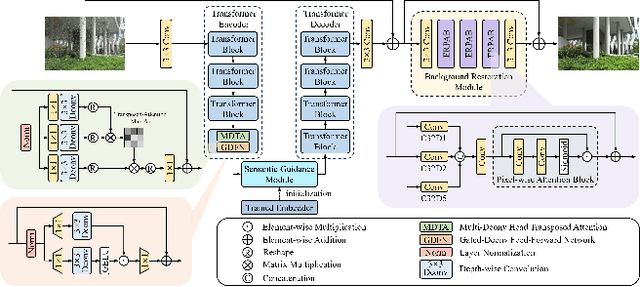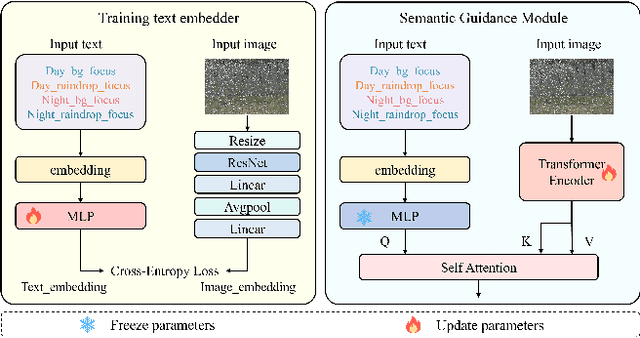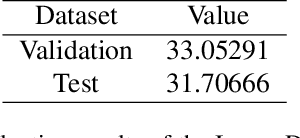Ruikun Zhang
A Preliminary Study for GPT-4o on Image Restoration
May 08, 2025



Abstract:OpenAI's GPT-4o model, integrating multi-modal inputs and outputs within an autoregressive architecture, has demonstrated unprecedented performance in image generation. In this work, we investigate its potential impact on the image restoration community. We present the first systematic evaluation of GPT-4o across diverse restoration tasks. Our experiments reveal that, although restoration outputs from GPT-4o are visually appealing, they often suffer from pixel-level structural fidelity when compared to ground-truth images. Common issues are variations in image proportions, shifts in object positions and quantities, and changes in viewpoint.To address it, taking image dehazing, derainning, and low-light enhancement as representative case studies, we show that GPT-4o's outputs can serve as powerful visual priors, substantially enhancing the performance of existing dehazing networks. It offers practical guidelines and a baseline framework to facilitate the integration of GPT-4o into future image restoration pipelines. We hope the study on GPT-4o image restoration will accelerate innovation in the broader field of image generation areas. To support further research, we will release GPT-4o-restored images from over 10 widely used image restoration datasets.
NTIRE 2025 Challenge on Day and Night Raindrop Removal for Dual-Focused Images: Methods and Results
Apr 19, 2025



Abstract:This paper reviews the NTIRE 2025 Challenge on Day and Night Raindrop Removal for Dual-Focused Images. This challenge received a wide range of impressive solutions, which are developed and evaluated using our collected real-world Raindrop Clarity dataset. Unlike existing deraining datasets, our Raindrop Clarity dataset is more diverse and challenging in degradation types and contents, which includes day raindrop-focused, day background-focused, night raindrop-focused, and night background-focused degradations. This dataset is divided into three subsets for competition: 14,139 images for training, 240 images for validation, and 731 images for testing. The primary objective of this challenge is to establish a new and powerful benchmark for the task of removing raindrops under varying lighting and focus conditions. There are a total of 361 participants in the competition, and 32 teams submitting valid solutions and fact sheets for the final testing phase. These submissions achieved state-of-the-art (SOTA) performance on the Raindrop Clarity dataset. The project can be found at https://lixinustc.github.io/CVPR-NTIRE2025-RainDrop-Competition.github.io/.
Spatial Transcriptomics Analysis of Spatially Dense Gene Expression Prediction
Mar 03, 2025Abstract:Spatial transcriptomics (ST) measures gene expression at fine-grained spatial resolution, offering insights into tissue molecular landscapes. Previous methods for spatial gene expression prediction usually crop spots of interest from pathology tissue slide images, and learn a model that maps each spot to a single gene expression profile. However, it fundamentally loses spatial resolution of gene expression: 1) each spot often contains multiple cells with distinct gene expression; 2) spots are cropped at fixed resolutions, limiting the ability to predict gene expression at varying spatial scales. To address these limitations, this paper presents PixNet, a dense prediction network capable of predicting spatially resolved gene expression across spots of varying sizes and scales directly from pathology images. Different from previous methods that map individual spots to gene expression values, we generate a dense continuous gene expression map from the pathology image, and aggregate values within spots of interest to predict the gene expression. Our PixNet outperforms state-of-the-art methods on 3 common ST datasets, while showing superior performance in predicting gene expression across multiple spatial scales. The source code will be publicly available.
LMHaze: Intensity-aware Image Dehazing with a Large-scale Multi-intensity Real Haze Dataset
Oct 21, 2024



Abstract:Image dehazing has drawn a significant attention in recent years. Learning-based methods usually require paired hazy and corresponding ground truth (haze-free) images for training. However, it is difficult to collect real-world image pairs, which prevents developments of existing methods. Although several works partially alleviate this issue by using synthetic datasets or small-scale real datasets. The haze intensity distribution bias and scene homogeneity in existing datasets limit the generalization ability of these methods, particularly when encountering images with previously unseen haze intensities. In this work, we present LMHaze, a large-scale, high-quality real-world dataset. LMHaze comprises paired hazy and haze-free images captured in diverse indoor and outdoor environments, spanning multiple scenarios and haze intensities. It contains over 5K high-resolution image pairs, surpassing the size of the biggest existing real-world dehazing dataset by over 25 times. Meanwhile, to better handle images with different haze intensities, we propose a mixture-of-experts model based on Mamba (MoE-Mamba) for dehazing, which dynamically adjusts the model parameters according to the haze intensity. Moreover, with our proposed dataset, we conduct a new large multimodal model (LMM)-based benchmark study to simulate human perception for evaluating dehazed images. Experiments demonstrate that LMHaze dataset improves the dehazing performance in real scenarios and our dehazing method provides better results compared to state-of-the-art methods.
Multi-user beamforming in RIS-aided communications and experimental validations
Sep 18, 2023Abstract:Reconfigurable intelligent surface (RIS) is a promising technology for future wireless communications due to its capability of optimizing the propagation environments. Nevertheless, in literature, there are few prototypes serving multiple users. In this paper, we propose a whole flow of channel estimation and beamforming design for RIS, and set up an RIS-aided multi-user system for experimental validations. Specifically, we combine a channel sparsification step with generalized approximate message passing (GAMP) algorithm, and propose to generate the measurement matrix as Rademacher distribution to obtain the channel state information (CSI). To generate the reflection coefficients with the aim of maximizing the spectral efficiency, we propose a quadratic transform-based low-rank multi-user beamforming (QTLM) algorithm. Our proposed algorithms exploit the sparsity and low-rank properties of the channel, which has the advantages of light calculation and fast convergence. Based on the universal software radio peripheral devices, we built a complete testbed working at 5.8GHz and implemented all the proposed algorithms to verify the possibility of RIS assisting multi-user systems. Experimental results show that the system has obtained an average spectral efficiency increase of 13.48bps/Hz, with respective received power gains of 26.6dB and 17.5dB for two users, compared with the case when RIS is powered-off.
Channel sensing for holographic MIMO surfaces based on interference principle
Aug 20, 2023



Abstract:The Holographic Multiple-Input and Multiple-Output (HMIMO) provides a new paradigm for building a more cost-effective wireless communication architecture. In this paper, we derive the principles of holographic interference theory for electromagnetic wave reception and transmission, whereby the optical holography is extended to communication holography and a channel sensing architecture for holographic MIMO surfaces is established. Unlike the traditional pilot-based MIMO channel estimation approaches, the proposed architecture circumvents the complicated processes like filtering, analog to digital conversion (ADC), down conversion. Instead, it relies on interfering the object waves with a pre-designed reference wave, and therefore reduces the hardware complexity and requires less time-frequency resources for channel estimation. To address the self-interference problem in the holographic recording process, we propose a phase shifting-based interference suppression (PSIS) method according to the structural characteristics of communication hologram and interference composition. We then propose a Prony-based multi-user channel segmentation (PMCS) algorithm to acquire the channel state information (CSI). Our theoretical analysis shows that the estimation error of the PMCS algorithm converges to zero when the number of HMIMO surface antennas is large enough. Simulation results show that under the holographic architecture, our proposed algorithm can accurately estimate the CSI in multi-user scenarios.
 Add to Chrome
Add to Chrome Add to Firefox
Add to Firefox Add to Edge
Add to Edge